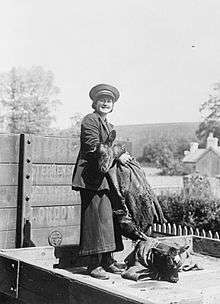Porter (railroad)

A porter is a railway employee. The role of a porter is to assist passengers at railway stations, and to handle the loading, unloading, and distribution of luggage and parcels. In the United States the term was formerly used for employees who attended to passengers aboard sleeping cars, a usage unknown to British or Commonwealth English where such staff are known as attendants or stewards,[1][2][3] terms which are also common in translation in non-English speaking European train travel.[4]
The word derives from the Latin portare, meaning "to carry." Hence, in railroad use, the application to someone who carries baggage and parcels of passengers, among other duties.[5]
History
United Kingdom
Porters arose in the Traffic Department of early railway companies, as junior staff grades in most of the independent railway companies. Station porters handled passengers' luggage, assisted passengers to and from trains, carried out general cleaning duties in the station and on its platforms, and often assisted on ticket barriers and in booking offices as they advanced towards higher grades. Goods porters (also known as parcels porters) worked in the handling of parcels and packaged goods, especially in left luggage offices and in relation to parcels vans on trains.
Porters were, in most railway companies, the most junior grade of station staff, although some companies had the more junior position of station lad, usually held by a young unskilled and unqualified teenager, who would aspire to the role of porter after training.
A typical career progression would see a porter advance to become a head porter, then a ticket collector or booking clerk, which could in turn lead to the senior roles of assistant station master or station master. Other career progressions were also common on some railways. Research at the London School of Economics has shown (with particular reference to the Great Eastern Railway) how advances in rail signalling in the late Victorian era led to a shortage of skilled labour, with many unskilled porters advancing to porter signalman, and ultimately qualifying as signalmen.[6]
Although porters are traditionally associated with railway stations, the role of travelling porter also existed on the British railways of the pre-grouping and Big Four era. Travelling porters travelled in the parcels cars of passenger trains organising luggage and parcels so that those required at any given station were always closest to the door upon arrival at that station. It was heavy manual labour, but was one of the roles taken over by female workers during the second world war.[7]
Australia
In Australia, a railway porter had various roles, similar to those described above. A baggage porter assisted with luggage; an operating porter assisted with safeworking duties; a station porter assisted with general station duties; and as in British usage a lad porter was a junior station porter.
United States
The US term porter has a somewhat different history and contemporary usage, than the rest of the world. Until desegregation had its effect in the United States in the 1960s, the occupation of porter was almost the exclusive province of African American men. It was the Civil War policy of George Pullman, head of the Pullman Company, who wished to tap into a huge potential work force that was also non-unionized. This eventually changed with the organization of the Brotherhood of Sleeping Car Porters under the leadership of A. Philip Randolph. In addition to carrying passengers' baggage to their berth or room, porters also provided personal services, such as clothes pressing and shoe shining.[8]
Contemporary use
United Kingdom
Although the role of porter originated in the United Kingdom, and continued after railway nationalisation, it went into decline by the 1970s, with the general station duties role taken by station attendants, and the role of carrying luggage largely abolished. In more recent times however, following the privatisation of British Rail, the role of porter has made a limited comeback, particularly at busy city stations and stations with high numbers of tourists and holidaymakers in transit.[9]
India
In India red-jacketed station porters are common at almost all stations across the network. Although Indian railway porters are not employed directly by Indian Railways they are centrally trained and licensed, holding a licence issued in the name of the President of India,[10] and their role is carefully regulated, with local services (such as porters' offices, lavatories, and canteens) provided by the railway company. Their role is the traditional luggage-carrying job at railway stations.[11]
United States
In the United States the term porter had the somewhat different meaning of a member of staff attending to passengers on board trains, particularly in sleeping cars, a role known as steward in most other countries. The American term is now obsolete, "attendant" being preferred.
See also
Footnotes
- ↑ Sleeping car Stewards referenced by the BBC on English-Scottish sleeper trains.
- ↑ Stewards referenced at Seat 61 international rail travel site.
- ↑ Alternative Attendant term at Rough Guides website.
- ↑ See sleeper Stewards referenced at ItaliaRail website.
- ↑ "Porter". Wiktionary. Retrieved 12 March 2018.
- ↑ Careers for the unskilled in the Great Eastern Railway Company, 1870-1913, by Peter Howlett, London School of Economics (Department of Economic History), published LSE, June 2001, page 12.
- ↑ Women and the Great Western Railway, by Rosa Matheson, published by Tempus Publishing, 2007, ISBN 978 0 7524 7432 8, e-published by The History Press, 2012, ISBN 978 0 7524 7431 1.
- ↑ Larry Tye, Rising from the Rails: Pullman Porters and the Making of the Black Middle Class, 2004, Macmillan, ISBN 0-8050-7075-3
- ↑ Busy Windermere railway station gets porter, The Westmorland Gazette (newspaper), 25 August 2009, accessed 8 October 2016.
- ↑ THE PORTER ECONOMY, The Great Railway Bazaar, Mayank Singhal, Businessworld Magazine, 8-15 Sep 2003, reproduced by The Centre for Civil Society.
- ↑ Men in red, The Hindu (newspaper), 7 August 2013, accessed 8 October 2016.